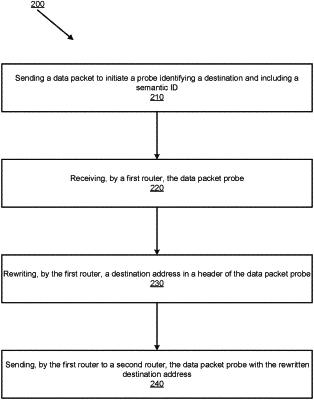| CPC H04L 45/745 (2013.01) [H04L 43/12 (2013.01)] | 11 Claims |

|
1. A method for validating data in a data structure used for forwarding packets by a network device, the method comprising:
receiving, at a router, a data packet probe including a segment identifier (ID), wherein the segment ID maps to a first interpretation by a receiving router to perform an action on the data packet probe to rewrite a portion of a destination address in a header of the data packet probe, and to redirect the data packet probe to the network device that initiated the data packet probe,
rewriting a portion of the destination address in the header of the data packet probe to generate a new destination address; and
forwarding the data packet probe to a next router in a path to a destination corresponding to the new destination address;
wherein the segment ID is an embedded segment ID includes a plurality of nested embedded segment IDs, wherein each of the plurality of nested embedded segment IDs is interpretable by at least one router along a forwarding path to the destination;
wherein the at least one of the plurality of nested embedded segment IDs instructs a first router to remove a first one of the plurality of nested embedded segment IDs and use a specified byte range located in the destination address in the header of the data packet probe to forward the data packet probe, and to rewrite the destination address in the header of the data packet probe without the first one of the plurality of nested embedded segment IDs and without the specified byte range.
|